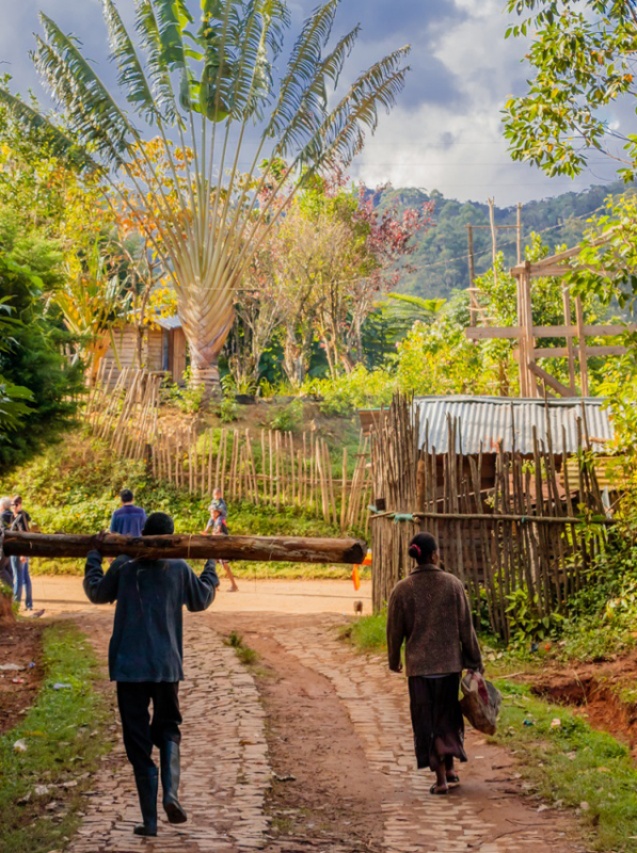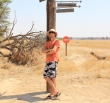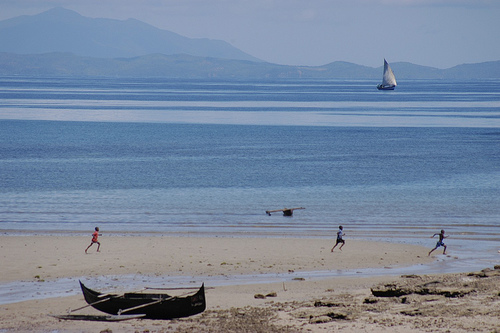Dan’s Adventures in Madagascar (Part I)
Life’s a 'gasy
Africa’s ready-made Eden Project with nature evolving at its own pace, unabated. Castaway from the mainland into the Indian Ocean, Madagascar is famous for a wide variety of endemic plant and animal life. It’s also home to people originally from Indonesia and the African continent, who became distinct tribes with a mix of Malayo-Indonesian and African-Arab ancestry.
 Antananarivo men by Daniel De Lapelin Dumont
Antananarivo men by Daniel De Lapelin Dumont
Being the fourth largest island in the world, Madagascar is quite a lot bigger than can be comprehended, but we all know now that the world maps we saw at school weren’t accurate. With a landmass of 587,713 square km, it is more than double the size of the United Kingdom. With little infrastructure and poor roads, exploring different parts of the island of Madagascar takes a good while.
 Antananarivo transport by Daniel De Lapelin Dumont
Antananarivo transport by Daniel De Lapelin Dumont
We had only 9 nights, just enough time to visit the tropical rainforests of Andasibe (closest rainforest to the capital, Antananarivo or ‘Tana’) and head south with Air Madagascar on a 2-hour flight to Fort Dauphine, a drier region just below the Tropic of Capricorn. Using Tana (Antananarivo) as the transport hub, we spent three nights there, accommodating our arrival, departure and bridging between the two other regions in our itinerary.
 Tana madagascar by Daniel De Lapelin Dumont
Tana madagascar by Daniel De Lapelin Dumont
Day one: Arriving in Antananarivo
Tana’s International Airport – Ivato- is small, but surprisingly, has a number of national carriers offering scheduled departures from the likes of Nairobi, Addis Ababa, Paris, and me from Johannesburg with SAA on a three-hour flight.
 Ivato airport by Daniel De Lapelin Dumont
Ivato airport by Daniel De Lapelin Dumont
A quick heads up for beach bums - SA Airlink is now offering direct flights from Johannesburg to Nosy Be’ in the far north, which is an ideal seaside getaway.
 Nosy Be Island by Daniel De Lapelin Dumont
Nosy Be Island by Daniel De Lapelin Dumont
Arriving at Ivato, passport control involves three or four different hoops to jump through, but visa issuing is relatively swift. Be sure to have 25 Euros (or equivalent USD) to hand over for the visa which is applicable to all visiting nationals.
 Antananarivo roadside by Daniel De Lapelin Dumont
Antananarivo roadside by Daniel De Lapelin Dumont
Once luggage is collected, it’s a good idea to buy some local currency in the airport. Do shop around for the best rate and steer clear of the touts by using an official Bureau de Change - some change a variety of world currencies but some are restricted to USD and Euro. At the time of writing (May 2017) 1 ZAR bought 190 Areiarey.
Tour guides and drivers are not allowed to wait inside airports in Madagascar, so if you are being met, your person will be waiting just outside the airport’s main exit. Expect porters and begging children (all perfectly harmless) vying for your attention all the way to your vehicle – thankfully the only time on the trip that this was a hassle.
 Antananarivo view by Daniel De Lapelin Dumont
Antananarivo view by Daniel De Lapelin Dumont
There are a number of hotels near the airport in the suburb of Ivato, which are convenient for early and late flights as the journey into central Antananarivo can take 2 hours in traffic. Tana has no rush hour to speak of but seems permanently congested. A pulsating mass of traffic around the capital relies only on the patience of drivers, roundabouts and traffic police to control the persistent flow of cars, buses, motorcycles, bicycles, rickshaws and all other manners of transport to keep it moving. There’s not a single traffic light in site and pop up shops and vendors adorn any available space to peddle their wares along the streets.
 Antananarivo shopfronts by Daniel De Lapelin Dumont
Antananarivo shopfronts by Daniel De Lapelin Dumont
 Antananarivo kid by Daniel De Lapelin Dumont
Antananarivo kid by Daniel De Lapelin Dumont
 Antananarivo market stall by Daniel De Lapelin Dumont
Antananarivo market stall by Daniel De Lapelin Dumont
Historically, Tana is the capital of the Merina people, the largest ethnic group of the city’s estimated 1.3 million inhabitants. Combining the surrounding urban areas brings this total metropolitan population to nearly 3 million. All 18 Malagasy ethnic groups, plus Chinese, Indians, Europeans and other origins, are well rooted in the capital.
 Tana local man by Antananarivo local man
Tana local man by Antananarivo local man
We eventually make it to our destination, the Ibis Hotel, which has clean comfortable rooms, hot shower, soft bed with fluffy pillows and a comfy duvet, just what is needed after a day’s travelling.
 Antananarivo budgeting by Daniel The Ibis has a decent restaurant and bar, but we decide to explore Antananarivo at night, following a recommendation to dine at the Cafe de la Gare restaurant. Housed, unsurprisingly in the historical central train station, the establishment is replete with typical colonial European grand architecture. The restaurant, frequented by a mix of tourist, locals and expats, has a superb menu, service and even local entertainment.
Antananarivo budgeting by Daniel The Ibis has a decent restaurant and bar, but we decide to explore Antananarivo at night, following a recommendation to dine at the Cafe de la Gare restaurant. Housed, unsurprisingly in the historical central train station, the establishment is replete with typical colonial European grand architecture. The restaurant, frequented by a mix of tourist, locals and expats, has a superb menu, service and even local entertainment.
 Antananarivo station by Daniel De Lapelin Dumont
Antananarivo station by Daniel De Lapelin Dumont
Day Two: Antananarivo Tour and on to Andasibe for a night walk in Analamazaotra Special Reserve
We check out of the Ibis after breakfast and enjoy a city tour of Antananarivo. Divided in three, the lower, middle and upper parts, it’s a mishmash of French colonial and Malagasy architecture.
 Antananarivo rooftop by Daniel De Lapelin Dumont
Antananarivo rooftop by Daniel De Lapelin Dumont
The city is dotted with agriculture, industry and enterprise: rice paddies, chicken coops, grazing Zebu cattle, makeshift fish farms, handmade brick factories, every inch is sustaining a livelihood somehow.
 Antananarivo water station by Daniel De Lapelin Dumont
Antananarivo water station by Daniel De Lapelin Dumont
Our guide talks us through the history to the present day and tells an all too familiar story of an African city struggling to keep up with the demands of its ever-expanding population.
 Antananarivo streets roofs by Daniel De Lapelin Dumont
Antananarivo streets roofs by Daniel De Lapelin Dumont
Afterwards, we stop at the Jambo supermarket to grab some snacks and supplies for the journey east to Andasibe.
The NR2 road is tarred, but full of potholes. The endless dips, turns and bends make the 142km journey between five and six hours. This is the main route to the coastal port city Toamasina, also called Tamatave. We must have seen a dozen broken down freight trucks and sometimes when navigating through smaller villages, these vehicles can be seen squeezing through the narrow streets. Others plying this route include the long distance taxi buses (taxi-brousse) bush taxi, plenty of bicycles, and other makeshift forms of transport.
 Antananarivo road by Daniel De Lapelin Dumont
Antananarivo road by Daniel De Lapelin Dumont
 Antananarivo truck by Daniel De Lapelin Dumont
Antananarivo truck by Daniel De Lapelin Dumont
We break the journey halfway for a picnic lunch before visiting the Mandraka Reptile Farm.
 Mandraka Reptile Farm by Daniel De Lapelin Dumont
Mandraka Reptile Farm by Daniel De Lapelin Dumont
 Mandraka Reptile Farm by Daniel De Lapelin Dumont
Mandraka Reptile Farm by Daniel De Lapelin Dumont
This stop offers great photo opportunities - getting close to a wide variety of chameleons, snakes, frogs, bats and even a type of local hedgehog, called a Tenrec.
 Mandraka Reptile Farm by Daniel De Lapelin Dumont
Mandraka Reptile Farm by Daniel De Lapelin Dumont
 Mandraka Reptile Farm by Daniel De Lapelin Dumont
Mandraka Reptile Farm by Daniel De Lapelin Dumont
After about an hour, we continue on, arriving at Andisabe Hotel in the late afternoon, to freshen up before our night walk along the fringe of the Analamazaotra Special Reserve, which forms part of Andasibe-Mantadia National Park of Madagascar.
 Analamazaotra Special Reserve by Daniel De Lapelin Dumont
Analamazaotra Special Reserve by Daniel De Lapelin Dumont
 Analamazaotra Special Reserve by Daniel De Lapelin Dumont
Analamazaotra Special Reserve by Daniel De Lapelin Dumont
We see plenty of nocturnal wildlife: Mouse Lemur, Woolly Lemur, Crab/Kite Spider and different frog and chameleon species. Our local guide is an expert in finding these small and often difficult-to-spot critters. Combined with the excitement of exploring at night, this makes for a fun activity.
 Analamazaotra Reserve by Daniel De Lapelin Dumont
Analamazaotra Reserve by Daniel De Lapelin Dumont
Our hotel offers a selection of local and European style evening meals, but the favourite is the Zebu steak with Madagascan pepper. Our guide diligently briefs us on the next day’s activities, before we retire.
 Analamazaotra Special Reserve by Daniel De Lapelin Dumont
Analamazaotra Special Reserve by Daniel De Lapelin Dumont
Day Three: Andasibe Rainforest
In mid-May we are lucky with the sunny weather, Andasibe is a rainforest, so wet weather is expected at any time of year. This often comes in short bursts that just as quickly disappear. We follow sage advice: wear good shoes, as the terrain will be muddy, pack a raincoat, wear comfortable long pants that can handle getting wet and use mosquito repellant – a must for exposed skin - as well as sunblock and a hat.
 Andasibe Forest walk by Daniel De Lapelin Dumont
Andasibe Forest walk by Daniel De Lapelin Dumont
After breakfast and a short drive to the park's entrance, our knowledgeable local Malagasy guide – fully conversant in English, meets us. The rainforest suffers cyclone damage and one section of the park in the area we were visiting had just re-opened. Repairing paths and bridges looks like hard work with limited tools, but access to natural materials is plentiful.
 Madagascar forest walk by Daniel De Lapelin Dumont
Madagascar forest walk by Daniel De Lapelin Dumont
Our quarry for the day is the Indri indri, the largest of lemurs. This primate has a head-and-body length of 64–72 cm, a weight between 6 and 9.5 kg and is famous for loud, distinctive songs.
 Andasibe Park by Daniel De Lapelin Dumont
Andasibe Park by Daniel De Lapelin Dumont
In the forest, guides communicate via cell phone and it doesn’t take long to spot a pair of Indri indri. The walk entails some bundu bashing off the path, following their howling call. Photography is challenging, with low light, lots of branches, limited space on the ground between trees and other tourists, jostling for a good view. The lemurs are also roving around for food, making it tricky getting good pictures, whilst dodging the droplets of water from above.
 Andasibe lemur eating by Daniel De Lapelin Dumont
Andasibe lemur eating by Daniel De Lapelin Dumont
 Andasibe lemurs by Daniel De Lapelin Dumont
Andasibe lemurs by Daniel De Lapelin Dumont
The 3-hour walk affords the would-be David Attenborough's sightings of the Common Brown Lemur, the Diademed Sifaka and discoveries of ant nests in trees, due to the very wet conditions.
 Andasibe forest path by Daniel De Lapelin Dumont
Andasibe forest path by Daniel De Lapelin Dumont
 Andasibe lemur by Daniel De Lapelin Dumont
Andasibe lemur by Daniel De Lapelin Dumont
We did not see the night owl nesting during the day, but at the end of the walk, our guide delights us all by spotting a Scops Owl, nesting in a tree just off the main road into the forest.
 Andasibe owl by Daniel De Lapelin Dumont
Andasibe owl by Daniel De Lapelin Dumont
After a rest, we enjoy an 11km ride on mountain bikes trucked in from Tana that make light work of the bumpy road and hills, to Vakona Forest Lodge where we ate delicious lunch.
 Vakona Forest cycle by Daniel
Vakona Forest cycle by Daniel
 Lemur Island accommodation by Daniel
Lemur Island accommodation by Daniel
The afternoon excursion to Lemur Island is another highlight. Tourists can get close to a variety of lemur species as the private sanctuary only accessible by paddleboat. There are mixed reactions about this type of animal interaction but for the untrained eye at least, there appears no undue stress caused to the lemurs that are coaxed with treats of fruit towards the human visitors.
 Lemur Island fruit by Daniel De Lapelin Dumont
Lemur Island fruit by Daniel De Lapelin Dumont
 Lemur Island lemurs by Daniel De Lapelin Dumont
Lemur Island lemurs by Daniel De Lapelin Dumont
 Lemur Island lemur encounter by Daniel De Lapelin Dumont
Lemur Island lemur encounter by Daniel De Lapelin Dumont
It is a great photo op and chance to see a wide variety of Madagascar's lemurs up close.
 Lemur Island lemur in tree by Daniel De Lapelin Dumont
Lemur Island lemur in tree by Daniel De Lapelin Dumont
 Lemur Island bush-tailed lemur by Daniel De Lapelin Dumont
Lemur Island bush-tailed lemur by Daniel De Lapelin Dumont
 Lemur Island lemur close-up by Daniel De Lapelin Dumont
Lemur Island lemur close-up by Daniel De Lapelin Dumont
We return to the lodge before sunset for dinner and agree it’s a perfect place to be.
Day 4: Rural Life in Madagascar
We begin our day with a cultural walk through a nearby village to experience the life of the rural Malagasy.
 Madagascar rural life by Daniel De Lapelin Dumont
Madagascar rural life by Daniel De Lapelin Dumont
After our village visit, we headed back to Antananarivo where we enjoyed an afternoon tea at the Hotel Colbert (other choices of accommodation include Lapa Soa and Hotel Palissandre).
For more about Madagascar, check out Dan's Adventures in Madagascar Part II which chronicles Day 5 to 9 of his trip or see Unspoilt Madagascar: Beautiful Beaches, Wildlife & Unique Cultures.
If you liked this post, these trips cover similar ground…
- Madagascar Vacation Package - Lemurs & Nosy Be Tour
- Best of Madagascar Tour - Beaches & Rainforests
- Private Madagascar Tour Package - Masoala Peninsula Safari
- Madagascar Vacation Package - Nosy Be Tour
- Madagascar Tour - South & Morondava Lodge Safari
- Madagascar Trip to Diego Suarez & Amber Mountain National Park



 A native Capetonian, Daniel’s earliest explorations of South Africa were family camping trips to the then small fishing villages of Cape’s west and south coasts. After qualifying in travel and tourism he was soon discovering Southern Africa, like his uncle TV Bulpin; and adventures such as tandem skydive and Bloukranz bungee - which were captured on VHS! He headed over the pond where his ‘world tour’ took in Europe, North Africa and Central America, before returning home to live in a suburb internationally renowned for senior citizens and shark attacks. When he’s not answering your calls and emails, you’ll probably find Daniel in the bush, with no reception or running water, but camera poised.
A native Capetonian, Daniel’s earliest explorations of South Africa were family camping trips to the then small fishing villages of Cape’s west and south coasts. After qualifying in travel and tourism he was soon discovering Southern Africa, like his uncle TV Bulpin; and adventures such as tandem skydive and Bloukranz bungee - which were captured on VHS! He headed over the pond where his ‘world tour’ took in Europe, North Africa and Central America, before returning home to live in a suburb internationally renowned for senior citizens and shark attacks. When he’s not answering your calls and emails, you’ll probably find Daniel in the bush, with no reception or running water, but camera poised.






